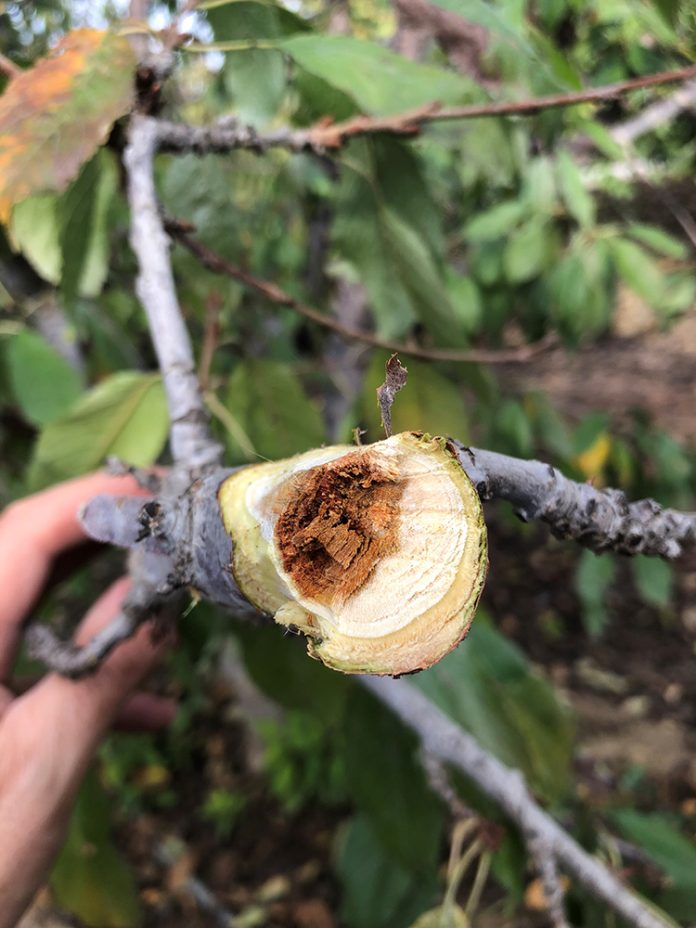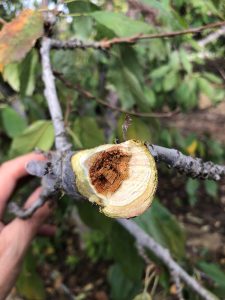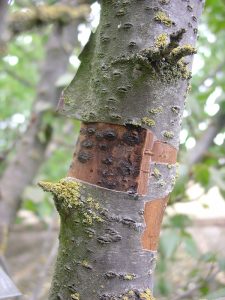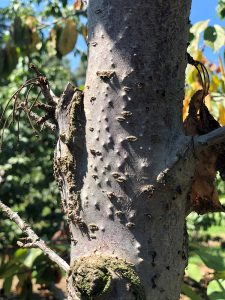
Fungal canker diseases of sweet cherry trees can be devastating to an orchard’s productivity and longevity and thus constitute a major threat to the cherry industry in California. Managing canker diseases has been challenging for growers as no control strategy alone suffices to manage these diseases. With funding from the California Cherry Board, the Trouillas Lab at UC Davis has worked during the past several years to improve management of canker diseases.
Main Fungal Canker Diseases of Sweet Cherry
Main fungal canker diseases of sweet cherry in California include Calosphaeria canker, Cytospora canker and Eutypa dieback, with Calosphaeria canker being the most widespread canker disease in the state. These diseases affect cherry trees in all cherry-producing areas worldwide, including Australia, Chile, France and Turkey. Canker diseases are caused by the plant-pathogenic fungi Calosphaeria pulchella, Eutypa lata and Cytospora sorbicola. These fungi infect and colonize the wood of cherry trees, killing branches, scaffolds and trunks, and causing important yield losses. Fungal cankers are to be distinguished from bacterial canker caused by the bacterium Pseudomonas syringae, which mostly affect the bark of cherry trees but also can lead to the killing of branches and entire trees.
Symptoms of Fungal Canker Diseases
A canker in woody plants usually refers to a lesion produced in the bark of twigs and branches. However, most fungal canker diseases colonize both the bark and internal wood tissues causing canker rots or wood cankers that persist for years. The dead area can block water and nutrient transport thus causing the dieback of affected branches. Wood cankers typically consist of reddish-brown to dark-brown discoloration of xylem tissues and may vary in shape from wedge-shaped to round, or irregular. Typically, if you cut through a disease branch on a cherry tree, canker infection will appear as vascular (wood) discoloration (Figure 1), which indicates a disruption in the flow of water and nutrients through the tree vascular system. It is also common for canker diseases to produce gumming near the infected area.

Biology of Fungal Canker Diseases
Calosphaeria pulchella and Cytospora sorbicola commonly produce fruiting bodies in sweet cherry trees. These can be observed easily beneath the periderm of dead or infected branches after peeling the external bark tissue with a knife. This method is a great way to diagnose canker diseases in the field. Calosphaeria pulchella produces fruiting bodies or perithecia occurring in groups with long cylindrical necks that emerged together through the bark at lenticel openings (Figure 2). Spores of Calosphaeria pulchella are primarily dispersed via rain and wind and infect open wounds such as pruning wounds. Sprinkler irrigation that wets the tree trunks also can contribute to spore release in cherry orchards, particularly during summer months. Cytospora sorbicola can be recognized as it forms pinhead-sized pimples pushing through the bark of cherry trees (Figure 3).

These pimples are the reproductive structures of Cytospora. Under humid conditions, masses of spores may ooze out of the fruiting bodies in long, brownish, coiled, thread-like spore tendrils. These spore masses are then rain-splashed to fresh pruning wounds and other openings where infections initiate. Perithecia (the reproductive structures) of Eutypa lata are rarely observed on cherry trees in California. These mostly form on riparian trees such as willow or ornamental tree such as oleander as well as in apricot trees and eventually grapevine. Eutypa canker disease is more common in the Northern San Joaquin and Sacramento valleys as well as in Contra Costa and San Benito counties, and rarely occurs south of Merced County. During rainfalls, spores of fungal canker pathogens are air-dispersed or rain-splashed onto fresh wounds such as fresh pruning wounds where they germinate and initiate infection. Fungal mycelium then colonizes the heartwood before expanding into the sapwood, causing wood discoloration and the typical canker.

Management of Canker Diseases
To best manage canker diseases, we propose an integrated, preventive approach that minimizes risks of infection of sweet cherry trees by fungal pathogens. This integrated approach involves disease avoidance and prevention, combining cultural, chemical and biological control practices. First, pruning should be performed to avoid rain and when dry weather is predicted for at least two weeks. Pruning of sweet cherry trees may be done after harvest during late spring and summer when conditions are warm and dry and when no rain is forecasted. Canker pathogen populations will be at their lowest during this period and the risk for infection is reduced. However, spore release and infection of pruning wounds can occur during late spring if rain occurs and during summer if sprinkler irrigation that wets trees is used in the orchard.
Overall, cold winter temperatures are unfavorable to pruning wound infection by Calosphaeria, and winter pruning may be considered particularly in orchards and regions where Calosphaeria canker represent the main canker disease. Indeed, spores of Calosphaeria pulchella will not germinate at temperatures below 15 degrees C (60 degrees F), and pruning during cold winter period can prevent infection of pruning wounds by Calosphaeria pulchella. Infection of pruning wounds by Cytospora sorbicola can be avoided also by pruning sweet cherry trees in the coldest parts of winter when temperature is below 10 degrees C (50 degrees F). Winter pruning, however, generally will not prevent infection of cherry trees by Eutypa if rain is present at the time of pruning. So, winter pruning is best done during cold and dry weather conditions, with no rain in the forecast.
Because pruning wounds serve as the main entry sites for canker pathogens, these must be protected following pruning of trees, especially if pruning occurs during the wet winter and spring months or during summer in orchards that receive sprinkler irrigation that wet the trees. Water from rain and sprinkler irrigation combined with wind are important factors for aerial dissemination of canker pathogens. Our laboratory recently evaluated the efficacy of different compounds to protect pruning wounds from infection by canker pathogens. Of the different fungicidal compounds tested, Topsin M (Thiophanate-methyl) and Quilt Xcel (Azoxystrobin + Propiconazole) performed best against Cytospora and Eutypa pathogens of sweet cherry, allowing significant disease reduction. Biological, Trichoderma-based products (e.g. Vintec®, RootShield® Plus) provided significant protection of pruning wounds against all canker pathogens, and performed best at reducing infection by Calosphaeria pulchella. Fungicide or biocontrol products should be applied immediately after pruning to avoid infection at pruning wounds.
When orchards are seriously infected with canker diseases and branch dieback occurs, remove diseased branches/limbs at least 4 to 6 inches below any sign of wood discoloration. The pruning cut should be made into healthy wood to ensure that all the disease has been removed. Incomplete canker removal wastes time and money with little to no benefit in disease management. Dead branches left in the orchard or adjacent to living trees provide inoculum for further infection and should be removed and destroyed.
It is also advised to regularly disinfect pruning shears, particularly after cutting through dead wood, using common sanitizers or a flaming torch. Note that wood grinding or wood chipping potentially could release an important number of spores in orchards that could infect pruning wounds. Accordingly, the grinding or chipping of dead cherry wood should be avoided until at least several weeks following pruning. Although burning of cherry wood is restricted, it is often the best option to get rid of fruiting bodies from cherry canker pathogens that have developed on dead wood. Storing dead wood near orchards also will have no effect at reducing inoculum sources unless the wood is thoroughly covered and protected from rain and irrigation water.
Topping cherry trees to encourage new vegetative growth also has been linked to severe sunburn damage in cherry orchards. Branches with sunburn damage then become highly susceptible to both fungal and bacterial canker pathogens. Techniques that help limit sunburn in cherry trees are encouraged to avoid canker disease outbreak in orchards. These may include proper pruning and training to promote adequate branch and tree structures as well as whitewashing, which consist of applying white paint to the interior of scaffold branches to reflect light and reduce bark heating from exposition to direct sunlight.
Management of canker diseases of sweet cherry is difficult due to the diversity of canker pathogens affecting sweet cherry trees in California. However, disease management may be achieved when considering multiple factors linked to disease spread and infection timing. These include the weather and weather forecast at the time of pruning and irrigation practices in the orchards as well as the orchard location and history of canker diseases. An integrated approach that combines disease avoidance and prevention is critical to achieve best control as no curative practices are available. While pruning must be conducted outside of the high-risk periods for infection, it is strongly advised also to protect pruning wounds with a fungicide or biological control agents.
Disclaimer: Mentioning of any active ingredients or products is not an endorsement or recommendation. All chemicals must be applied following the chemical label, local and federal regulations. Please check with your pest control adviser to confirm rates and site-specific restrictions. The author is not liable for any damage from use or misuse.


















